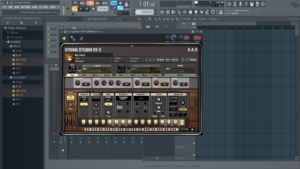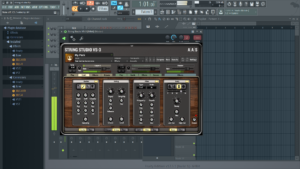Applied Acoustics Systems continues to be one of the leading lights when it comes to physical modeled synthesizer and effects plugins. We previously covered their Objeq Delay and Objeq effects: the former for the desktop and the latter on the iOS platform. They are both able to transform basic sounds into something otherworldly, as evidenced by Object Delay’s funky beat-mangling on Church of Hed’s Sandstoned No. 2.
AAS recently released String Studio VS-3, a flexible synth plugin based on the company’s state of the art string oscillator design. It’s a fresh version, superseding VS-2, with new multi-timbral support and two modulators that add a sense of motion to a patch. Thankfully, VS-3 is fully compatible with patches created in VS-2
String Studio VS-3 Features
- Unique String-Based Physical Modeled Synthesis
- Two-Voice Multi-Timbral Architecture
- Two Modulators Support MIDI Controllers
- Filters, LFOs, Envelopes, and more
- Enhanced Library with Patches from Richard Devine, Thiago Pinheiro, and more
- Multi-Effects Include Reverb, EQ, Compressor, Delay and more
- Import Microtonal Tunings using Scala File Format
- Supports Most Popular Plugin Formats
- Available from AAS for $199
Sound designers or electronic musicians looking for new sonic inspirations need to check out String Studio VS-3. A unique and flexible architecture makes it easy to conjure fresh new ideas for your next project. It belongs in the arsenal of those forward-looking sonic artists among you.
The Intuitive String Studio Interface
If you are familiar with AAS’s other plugins, diving right into String Studio VS-3 is a breeze. A Utility section at the top provides access to VS-3 patch library (AAS calls patches “sounds”) and other functionality, including the Layer mixer. You are able to layer or split the two voices as needed. The interface makes it easy.

Below the Utility section lies the meat of String Studio’s interface. This includes two identical tab menus for each synth voice, plus a separate Master effects section. The tab menus include separate sections titled Play, Synth, Effects, and Browse.
The Play section provides access to most commonly used parameters for live or real-time studio performance; this includes the arpeggiator control and basic effects functionality. The Synth section is where the fun lies, as you are able to tweak parameters related to the physical model in your patch. The Browse tab accesses the patch library, letting you peruse different patches and layers.
A Robust Collection of String Oscillators
The synth architecture of the VS-3 closely mimics that of a stringed instrument, as evidenced by the Synth section of the plugin. Simply tweaking the wide range of the parameters is one of the most fun aspects of String Studio. I am still a proud owner of the Korg Prophecy and Z1 after two-decades, so physical modeling synth architecture ranks among my favorites. AAS makes programming this synth architecture fun, easy, and rewarding.

String Studio VS-3 provides three main oscillator types: bowed string, plucked string, and hammered string. Within those three categories, a variety of picks, bows, frets, dampers, and the string model itself offers additional options within the Exciter module. Perusing the copious patch library gives a good idea of the sound design possibilities with each, but just playing around with the various parameters also provides insights and inspiration.
Modifying the parameters in the Body module is also useful, especially with percussive patches. Being first a drummer, I tend to gravitate towards these kinds of sounds, especially when physically modeled. Once again, explore the patch library for sonic ideas and read the excellent AAS manual for String Studio VS-3 to garner additional insights on the physical models.
More Familiar Synth Features Abound
A versatile filter helps give patches a sound more akin to a traditional synth. Most of its standard parameters are self-explanatory. The fresh support for two modulators lets you target certain synth parameters with a MIDI controller. Once again, this approach adds a sense of motion and expressiveness to your sonic proceedings.
Other useful features include an arpeggiator with a cool rhythm pattern feature, a vibrato module, and the ability to load microtuning tables. The latter is especially helpful when designing an otherworldly stringed instrument, perhaps the bicycle wheel lookalike instrument played by Spock in the original Star Trek series?
As noted earlier, each voice gets its own multi-effects module, along with a master one for the entire patch. Delay, reverb, EQ, compressor, flanger, and more are all available to finish off your patch. There is also a Distortion module in the Synth section, paired with the Body module.
Ultimately, I think String Studio VS-3 works the best when focused on more creative types of sounds, as opposed to emulations of patches created by a traditional subtractive synth. The included Richard Devine Sound Pack provides copious examples of what’s possible when the shackles are removed. Thankfully, the intuitive user interface makes creating your own patches – or tweaking a preset – an easy process.
Applied Acoustics has another winner on their hands with String Studio VS-3. If physical modeled synth architecture seems daunting, AAS makes it easier than ever before. The plugin warrants and rewards experimentation. It’s now possible to create sounds that uniquely combine realism with the surreal. Recommended.
